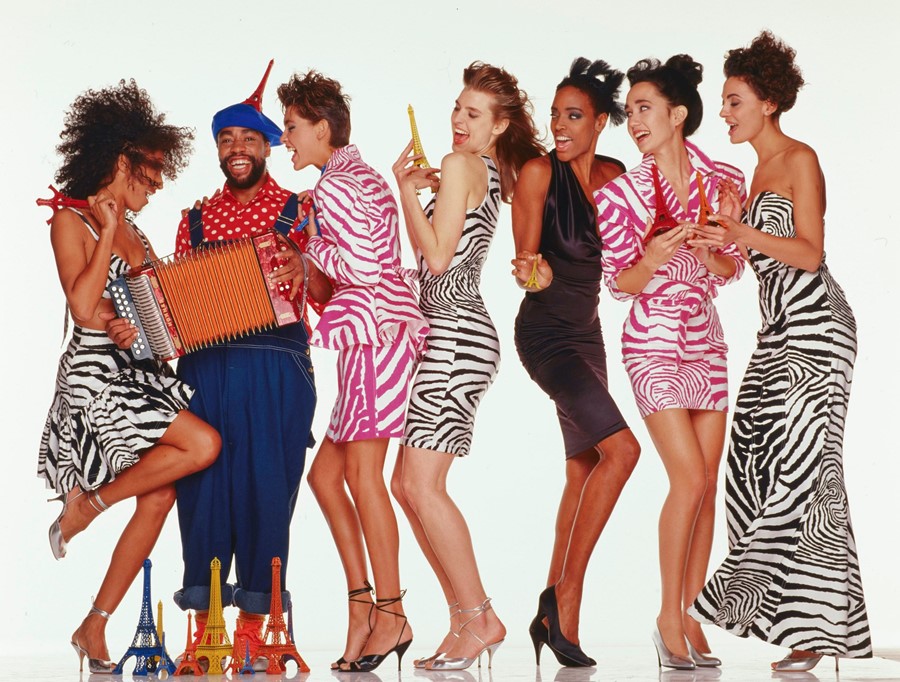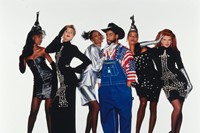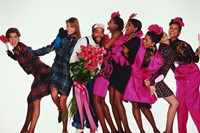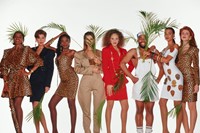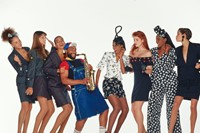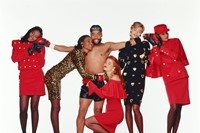At a time when conversations about race, gender and sexuality were taboo, the Mississippi-born designer put them fearlessly on the runway. Now, 30 years after his death, a new exhibition and book celebrate his sparkling legacy
As a gay Black man hailing from Vicksburg, Mississippi during segregation, fashion designer Patrick Kelly (1954–1990) was an unstoppable force, breaking every barrier in his path with an inimitable sense of style, wit and panache. In 1988, he was the first American and first Black person to become a member of France’s prestigious Chambre Syndicale du Prêt-à-Porter, which governs the ready-to-wear industry.
Kelly – who dressed icons like Naomi Campbell, Grace Jones, Madonna and Iman – exemplified the spirit of the 1980s with his provocative and playful designs. In an era where camp reigned supreme, Kelly led the pack with his signature blend of silly, sexy and saucy energy. The designer embellished sultry silhouettes with buttons and bows, flowers and dice, creating a world where anything went. At a time when conversations about race, gender and sexuality went unspoken, Kelly put them on the runway without fear.
“I want my clothes to make you smile,” said Kelly, whose playful and provocative approach revolutionised fashion in ways that can be clearly seen some three decades after his death.
Before Kelly died of Aids-related illnesses on New Year’s Day 1990, he was poised to reach new heights, having just signed a $5 million production deal with Warnaco. “For years I thought [his work] was pretty much forgotten, which saddened me and I wanted to do everything to place his archive at a museum,” says Bjorn Guil Amelan, Kelly’s life and business partner. Eventually, he did just this, finding a home at the Philadelphia Museum of Art, which organized the touring exhibition, Patrick Kelly: Runway of Love, now on view in its new iteration at the de Young museum in San Francisco. Kelly’s iconic designs are presented alongside footage from his groundbreaking runway shows, photos, sketches, and collages. The de Young’s presentation is also accompanied by the first book and catalogue about the trailblazing designer.
Although Kelly made you look, he didn’t explain. He simply started the conversation by refusing to go along with the status quo. It began with a simple observation at the age of six, when his grandmother Ethel B Rainey showed him a fashion magazine she brought home from her white employer. He immediately noticed there were no Black people in it. After Rainey explained, “Nobody has time to design for them,” Kelly announced his plan to become a fashion designer.
As a teen, Kelly discovered Paris couture through Ebony Fashion Fair, the travelling extravaganza that brought high fashion to Black American audiences. “I was really impressed, and excited and mad. Even if you had money in Mississippi, who went to see a fashion show?” Kelly is quoted as saying in the book. There was only one solution: to get out of town.
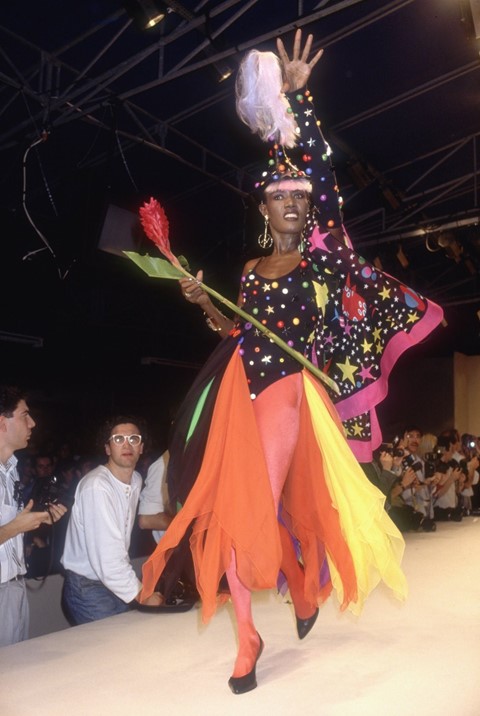
Between 1974 and 1978, Kelly lived in Atlanta and got his start staging fashion shows, giving Iman her American catwalk debut in 1976. Pat Cleveland also walked for Kelly and quickly became one of his first clients. Ready for the big time, he moved to New York in 1978 to study at Parsons School of Design. But Kelly preferred nights at Paradise Garage to days behind a desk. Sensing his frustration with the city’s relentless grind, Cleveland anonymously bought Kelly a one-way ticket to Paris in 1979 – a move that would change his life and establish him as one of America’s greatest fashion designers, albeit as an expatriate.
Fate struck again in 1982 when Kelly met Amelan in passing at the opening of Willi Smith’s New York showroom, and then again in Paris during early 1983 at a dinner party. Amelan recalls, “He was talking about what he was doing as a fashion designer, and I was very impressed. He was working from home and invited me to come see what he was doing, which I did the following day.”
At the time, Kelly was living in a small apartment that he had obtained while briefly working with Paco Rabanne. “Patrick had a portable sewing machine and fabric on the bed. I later found out one didn’t sleep in the bed as long as there was fabric on it, which meant there was work to be done. He was working non-stop,” says Amelan.
The designer kept an open-door policy with a rotating cast of African-American models who would frequently drop by and lend a hand to the day’s activities. “Patrick was the most outgoing person I have ever known. There was something very magnetic about his personality, his smile, charm and energy that swept you in immediately,” Amelan says. “I always felt that within five minutes you fell in love with him – and within five years you knew nothing about him. Everything about him seemed so open but it was actually the opposite and that was quite fascinating.”
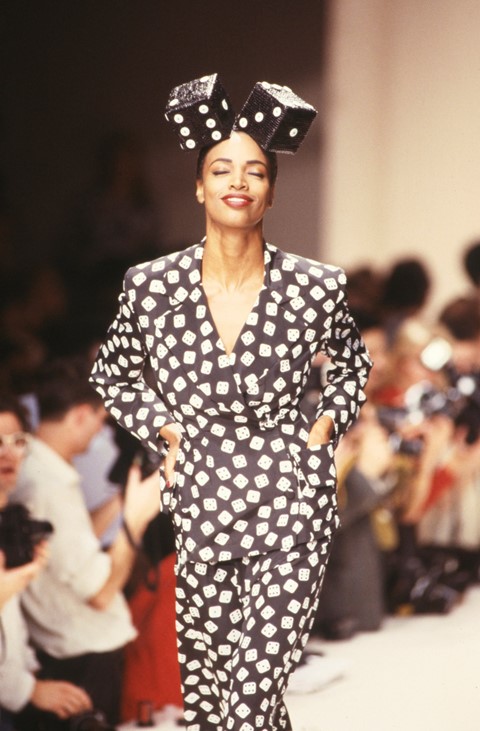
Enigmatic yet exuberant, Kelly recognised that camp was the ultimate way to challenge the status quo without ever breaking a sweat. For the finale of the Autumn/Winter 1986-1987 show, Cleveland walked the runway in a design inspired by Josephine Baker’s famous banana-skirt costume. Drawing a direct through line from Cleveland to Baker to Sarah Baartman – the “Hottentot Venus” who was taken from her South African home to be exhibited as a freak show attraction r in 19th-century Europe – Kelly confronted the white gaze long before fashion was ready for the conversation.
Using wit and warmth, Kelly reclaimed racist tropes like golliwogs, mammy dolls and Sambo figurines after Amelan unwittingly bought him one as a birthday gift. “I knew about racism in America but I did not realise how loaded with negativity those objects were,” recalls Amelan. “Instead of reading me the riot act, Patrick said, ‘We will start collecting these,’ but he never explained the history of the object.”
The collection was permanently displayed and became the logo of the house. Then Kelly took it to the next level and began incorporating them into his designs. “I get a lot of criticism from Blacks and from whites and from everybody about who I am and my image,” Kelly said during a 1989 talk at the Fashion Institute of Technology. “And with the Blacks I always say, if we can’t deal with where we’ve been, it’s going to’ be hard to go somewhere.”
Kelly took a calculated risk, willing to lose sales to force Americans – and the world at large – to face racism. Many refused to look, turning a blind eye. “At the time I didn’t understand why the buyer at Bergdorf Goodman told me they could buy and display it in their stores,” says Amelan. “Patrick didn’t explain but in hindsight, his attitude was that by appropriating and recontextualising these racist objects, one removes the poison they have, whereas by hiding them, one maintains their power.”

For Kelly, everything was love. It infused everything he did. He created a “Love List” to celebrate and uplift what spoke to his heart, and infused joy into every one of his designs. Kelly loved families, especially grandmothers and mothers; pearls and popcorn; women of all shapes and sizes; big overalls; lycra dresses and spareribs; churches; and dolls. The list goes on, as does his legacy – all the more prescient in the light of history.
“At Patrick’s funeral, Gloria Steinem said that the world divides us with gold and surely Patrick united us with buttons, bows, and seashells,” says Amelan. “I think that’s what people feel when they see the work and it’s what we need these days.”
Patrick Kelly: Runway of Love at de Young Fine arts Museums of San Francisco through April 24, 2022.
